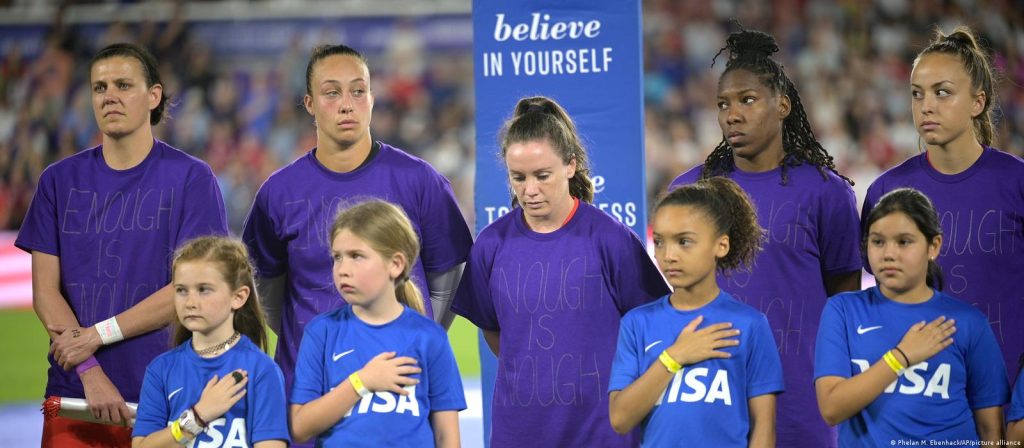
While the dispute between the Canadian national women’s football team and the sport’s governing body has gained global attention over the past week, it’s just the latest development in a longstanding struggle, according to former Canada midfielder Helen Stoumbos.
«When I saw this happening, with the girls coming out and wanting to strike, it just went back to when we were playing 25 years ago. We had the same issues, the same concerns, fought the same battles,» Stoumbos told DW, referring to last weekend’s short-lived players’ strike.
«There needs to be accountability. There needs to be transparency,» she said, echoing some of the words voiced by the current players this week.
Players like Christine Sinclair and Janine Beckie, who were the public faces of the ill-fated strike, which the players ended under the threat of massive legal action by Canada Soccer. They were both in the starting 11 as the Olympic gold medalists faced the World Cup champions, the United States, in both teams’ opening matches of the SheBelieves Cup in Orlando on Thursday night.
The 2-0 defeat was clearly an afterthought even before it had begun for the Canadians, coming toward what has been arguably the most difficult week in their history, which incidentally began with another 2-0 loss to the United States in 1986.
Front of mind for the players was clearly their very public dispute over not just equal pay, but equal treatment in general to their male counterparts.
‘Enough is enough’
As they had promised, they used the pre-match phase to voice their displeasure, wearing purple jerseys with «Enough is Enough» written on the front – even as they sang their country’s national anthem. Purple has historically been associated with the battle to achieve gender equality. Their protest was supported by their opponents.
«Considering the current circumstances, our players will continue to wear purple until our association has standards in place that ensure equal treatment and opportunity,» read a prematch statement issued by the Canadian Players Association, which represents the women.
Just prior to kickoff, the Canadians changed into their traditional red kit, keeping the purple tape they had wrapped around their wrists. The final scoreline could have been much worse, had the Americans not been so wasteful in front of goal.
After the match, Canada captain Christine Sinclair, whose 190 goals are the most scored by any international, woman or man, conceded that her team just weren’t up for it on the night.
‘Mentally exhausted’
«Either we’re fighting for everything and come out on fire, or we come out flat. And I think you saw those first 10, 15 minutes, we came out flat,» the 39-year-old forward said.
«I think we looked like a team that was tired, a team that’s mentally exhausted, coming up against a team, I mean, they’re defending World Cup champions for a reason, and you have to be at your best to compete with them. And we weren’t tonight.»
While Canada’s men have also been at odds with Canada Soccer, including a boycott of a friendly against Panama last year, the women feel even harder done by, pointing to figures from 2021 that show that the federation spent a total of $11 million (€10.3m) on the men’s team and $5.1 million on the women.
For its part, Canada Soccer has pointed to what it termed its «proven track record» of supporting the women’s game and said that pay equity was «at the core» of ongoing player negotiations.
Hollow words, according to Stoumbos, a cofounder of the Canadian Women’s Soccer Alumni Association.
«The proof is in the pudding,» she stressed. «Actions speak louder than words. And what you’re seeing is just not the case.»
At the same time, though, the woman who in 1995 scored Canada’s first-ever goal at a World Cup, hasn’t given up hope.
«What has to happen now for somebody to actually take notice and maybe for Canada Soccer to show some transparency?» she asked. «I don’t know how bad it has to get for that to happen or at what point. But I’m hoping that this is kind of the catalyst to actually start to look into these things that have been discussed for 30 years.»
Another strike looming?
Still, there is no quick fix in sight. The Canadian women were forced back to work on the weekend not only due to the threat from Canada Soccer, but also by the fact that they weren’t in a legal strike position under labor law in Ontario, the province where the federation is based. By the next international break in April, they will be.
The dispute has not only drawn a lot of media attention, but even the Canadian parliament is set to weigh in. The House of Commons heritage committee has invited Canada Soccer bosses to meet to discuss the matter next month.